Foreign Insulators
by Marilyn Albers
Reprinted from "Crown Jewels of the Wire", April 1995, page 6
IS IT A CD 511 OR A CD 512?
WE ASKED WOODY.....
We’ve all read Bernie Warren’s account of the fabulous trip he and Jim
Bergman made to Uruguay last fall. (If you missed this, go back and read your
January and February 1995 issues of Crown Jewels.) As you might guess, their
chief objective was to find insulators, and find them they did! They brought
home 10 of the 14 styles of glass insulators known to have been manufactured and
used in Uruguay, including new color listings for several of them. The best news
is that they had enough extras to share with other collectors. What a tremendous
contribution they made to the hobby!
Bernie and I had quite a discussion about one of the CODARVI styles he
brought back. It’s unembossed, it’s made of clear glass, and it has the
exact same profile as a CD 512. In fact he called it a CD 512, but I questioned
this because it has no inner skirt. He and Jim found several others exactly like
it - no inner skirts there either. But Bernie was convinced. “Marilyn”, he
said patiently, “it’s a CD 512" (period!). I can certainly see how he
would come to this conclusion. Glancing at it quickly, Bernie’s insulator
appears to be identical to the CD 512 shown in Glass Insulators from Outside
North America. But if you look closely at the scale drawing and the photo
presented there, you’ll see that Woody assigned that number to a Uruguayan
insulator with an inner skirt, and though these two pieces “appear” to be
the same style, that difference is significant. They are not the same CD.
Woody
has carefully gone over each example and has come to the conclusion that these
recent “similar to” CD 512’s are simply unembossed variations of CD 511.
He points out that the base diameters, top diameters, and heights of CD 511 and
Bernie’s insulator are identical. Regarding the embossed CD 511, he says “it
appears that the molds were machined out on an angle to provide a stronger
insulator and a better tying surface. This slight variation would not indicate
the need for separate CD numbers.” It makes me wonder if the more slender
appearing CD 511 and the CD 512 were part of an earlier production run?! The
photo and drawings shown below should answer any further questions about CD
numbers for these 3 insulators.
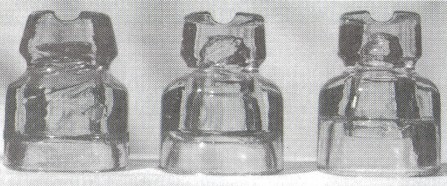
Left - CD 511, embossed, no inner skirt
Center - CD 511 variation, unembossed, no inner skirt
Right - CD 512, unembossed, has inner skirt
Woody has said so many times that a CD number was never meant to describe an
insulator exactly, just approximately. A perfect example is CD 145, which
classifies all similar “beehive” styles under one CD number. Jack Tod had
some words of wisdom on this subject, too. He believed that a U-number should be
used strictly for identifying a particular insulator style, and even admitted
that while he may not always have chosen the best place to put it in the style
chart, it wasn’t fatal. That number still worked when collectors wanted to
communicate by phone or letter. That applies to CD numbers, too.
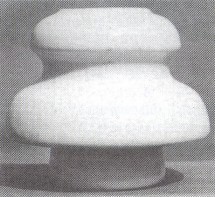
A GRAND OLD CLASSIC
This insulator is a real treasure. Jeff Hogan (Federal Way, WA), former owner
of the piece, picked it up at a show but had no idea of its age, where it was
used or what company made it. It’s obviously old but well preserved. It is
also very small for a multipart. A decision is pending on whether it should have
a U-number (because of its size) or an M-number (simply because it’s a
cemented two piece)

Its widest diameter is 4-3/4" and the total height of the piece is 4-1/8". Very small threads can be seen through breaks in the black cement
that lines the 1" pin hole. The top shell is glazed white, but the surface
is bumpy and crude, indicating that the porcelain is not of the best quality.
The cream colored base is smooth and obviously made from a finer grade of
material, indicating that the two parts were probably made at different plants
or at different times and assembled later. As you can see in the photo above,
the 1/4" circular ridge on the dome served as a rest for the insulator
during the firing process. A bit out of the ordinary, but I guess it worked!

“Embossing on
glass insulators” |

“Incuse marking on
porcelain insulator” |
The incuse marking on the top shell really made all kinds of bells ring in my
head. It is nearly identical to the P/F.C trademark used by ANCIENS
ETABLISSEMENTS PARVILLEE FRERES & CIE (“Long Established Plants of
Parvillee Brothers & Co.”), a French insulator manufacturer that was in
business at least as early as 1906 and as late as 1941. It is doubtful that the
company still exists, at least under that name. Headquartered in Paris, they
owned and operated three factories in different departments (states) of France.
At least one of these produced a complete line of high and low voltage glass
insulators, while the one located in the city of Cramoisy was designated as the
company’s laboratory and electrotechnical porcelain insulator factory. The
third one could have manufactured either glass or porcelain products, we just
don’t know.
The two trademarks differ only in the style of letters, their arrangement
within the circle and the number of periods. I doubt seriously if these
represent two different companies. More likely they were both intended to
represent Parvillee Brothers and/or specific plants within the company. The
trademark with P over F.C, as used on all their glass insulators, would be for
ANIENS PARVILLEE FRERES & CIE, while the variation with P.F. over C might
identify the insulator as a product of the porcelain factory, i.e. PARVILLEE
FRERES (located in) CRAMOISY. Another thought is that these trademarks could
represent different time periods during the company’s existence.
AN INSULATOR
FOUND IN TIBET
Bronson Hoffman (San Diego, CA) sent me a letter in December, 1994, along
with this photo of an insulator he had just received, asking if I had seen
anything like it before. A few weeks later I was able to view it in person. His
brother came upon a couple of these in Tibet, about 50 miles north of the border
of Nepal - above the North Mustang region. The exact location in Tibet (a self
governing region of China) was the town of ZHONGBA. Knowing Bronson was into
insulators, his brother brought them home as a gift. He thought they had been
made in China. The insulator is of a light gray color and doesn’t appear to be
very old. It classifies as a U-1451. The 1/2" pin hole with its tiny
threads resembles that of the British Cordeaux style, which was designed to
screw directly onto a metal pin, so I am assuming this one did also. I do not
recognize the blue underglaze ink stamp on the crown, so if any of our readers
can attribute this to a particular manufacturer, please write and let me know.
The number ‘70’ may indicate the year of production. Truly an interesting
piece!

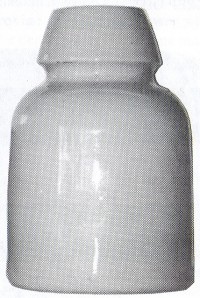
MORE SIGNS
OF A SERIOUS
COLLECTOR
These two electrical warning signs were found in the Czech Republic and the
words are in the language of that country. The larger of the two is very
attractive, with colors of black, white, yellow and red enameled on heavy iron.
It is a perfect 11-3/4" square. The top third of the sign translates to “ATTENTION
ELECTRICAL EQUIPMENT"; the middle section says “DO NOT QUENCH WITH WATER”;
and the lower portion means "KEEP OUT".
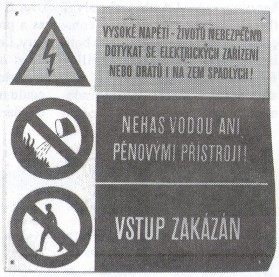
The second sign, made of heavy cast aluminum, is curved to fit the pole. It’s
not as flashy looking but it’s very old and has lots of character! It measures
5-1/2" by 6-1/2". The warning is “IT IS DANGEROUS TO TOUCH WIRES
THOUGH FALLEN TO THE GROUND”.
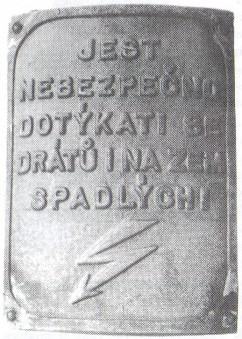
Many thanks to our collector friends in the Czech Republic - Frantisek Danek
of Obratan, who sent the signs, and Miroslav Immer of Prague, who helps
Frantisek with his research and translates all the many letters he receives from
and/or sends to his insulator friends in other parts of the world.
| 